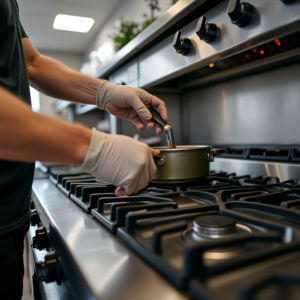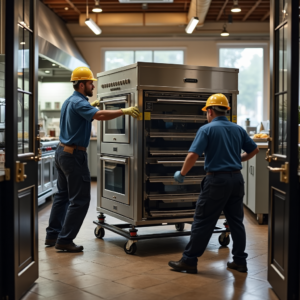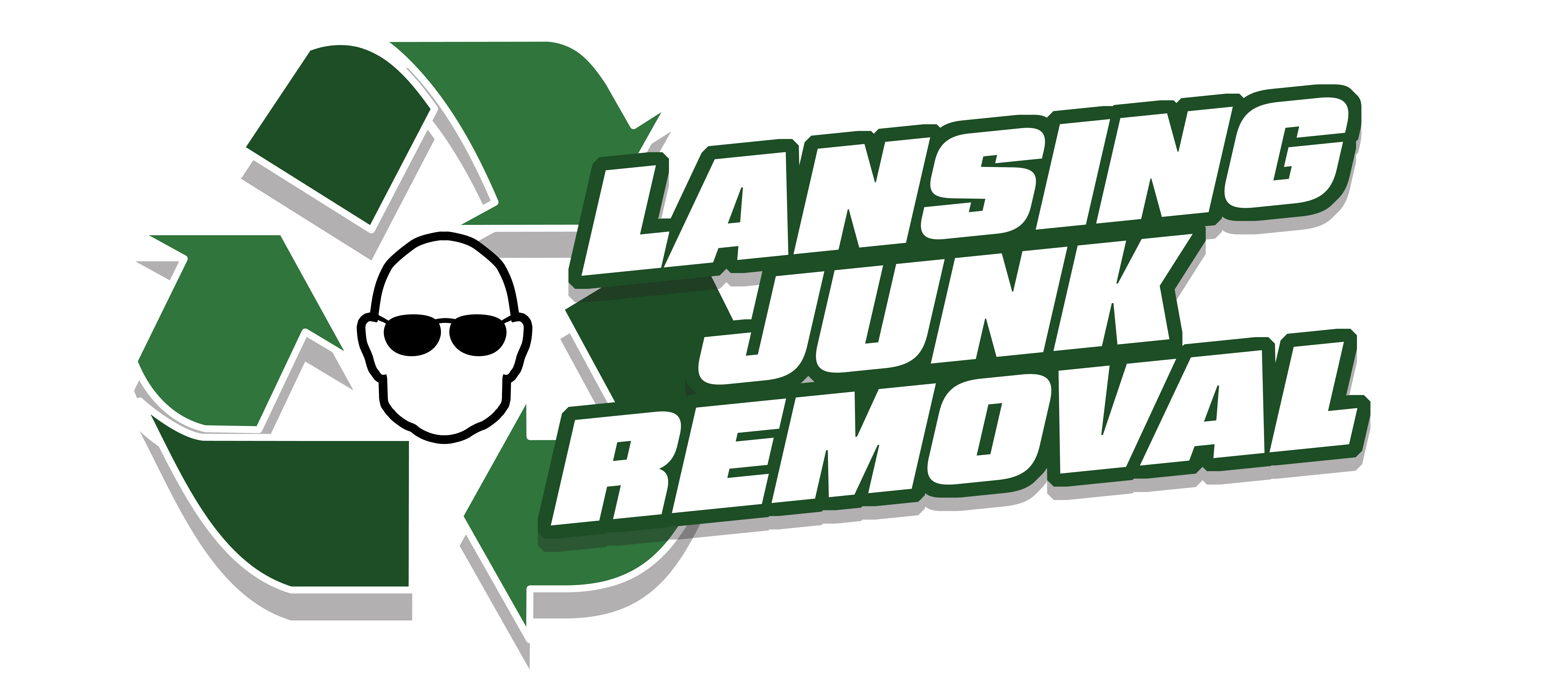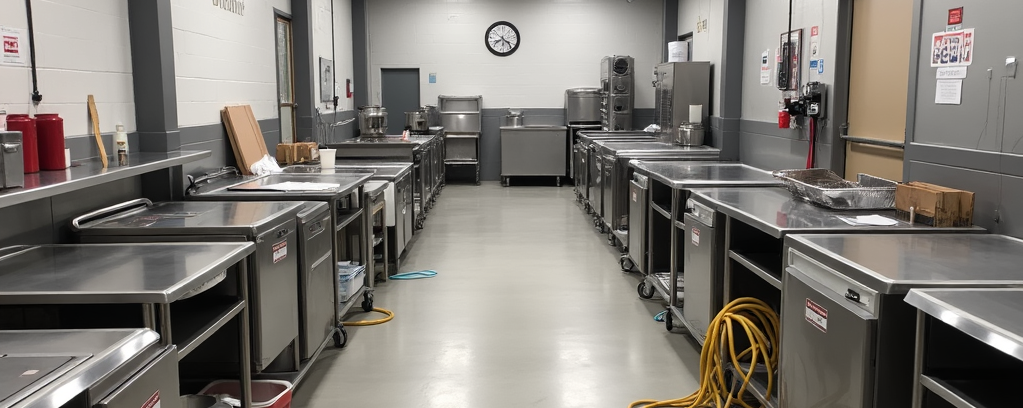Restaurant equipment doesn’t last forever. Commercial kitchens operate under intense conditions—high heat, constant use, exposure to grease, and food debris all take their toll on even the highest quality equipment. When these valuable tools reach the end of their useful life, proper removal becomes essential for maintaining operational efficiency.
Table of Contents
- Why Restaurant Equipment Cleanouts Matter
- Planning Your Restaurant Equipment Removal
- Efficient Removal Strategies to Minimize Downtime
- Sustainable Disposal Options for Restaurant Equipment
- Working with Professional Junk Removal Services
- Preventing Future Cleanout Challenges
- FAQs About Restaurant Equipment Cleanouts
Why Restaurant Equipment Cleanouts Matter
Outdated or malfunctioning equipment creates significant problems beyond just taking up space. Old appliances often consume more energy, leading to higher utility bills. They may pose safety hazards from electrical issues or gas leaks. Most importantly, equipment failures during peak service times can be catastrophic for your business, resulting in lost revenue and disappointed customers.
Regular business cleanouts provide an opportunity to evaluate your kitchen’s functionality and make strategic upgrades. By systematically removing old equipment and replacing it with modern, energy-efficient alternatives, restaurant owners can improve workflow, enhance safety compliance, and boost overall productivity.
 Planning Your Restaurant Equipment Removal
Planning Your Restaurant Equipment Removal
The difference between a smooth equipment transition and a costly disaster often comes down to proper planning. Restaurant owners should begin the planning process at least 1-2 months before the intended removal date, allowing ample time to coordinate all necessary aspects of the cleanout.
Start by creating a comprehensive inventory of all equipment scheduled for removal. Document each item’s dimensions, weight, special handling requirements, and whether any disconnection of utilities is required. This inventory becomes your roadmap for the entire removal process.
Timing is crucial when scheduling restaurant cleanouts. Consider these factors:
- Schedule removals during your off-season or slowest business periods
- Plan for overnight work when possible to minimize impact on regular service hours
- Allow for unexpected delays by building extra time into your schedule
- Coordinate with equipment suppliers to minimize the gap between removal and new installation
Proper communication with staff is equally important. Make sure everyone understands the timeline, how their work areas will be affected, and any temporary procedures that will be implemented during the transition period.
Efficient Removal Strategies to Minimize Downtime
The primary goal of any restaurant equipment removal should be minimizing operational disruption. Working with professional junk removal specialists who understand the unique demands of food service environments can dramatically reduce downtime.
Section-by-section removal proves more effective than attempting to clear the entire kitchen simultaneously. By compartmentalizing the process, you can keep portions of your kitchen operational while work proceeds in other areas. This phased approach allows for continued food preparation, albeit at a reduced capacity.
Equipment pre-processing is another vital strategy. Before removal day:
- Disconnect all utilities according to manufacturer specifications
- Empty, clean, and defrost refrigeration equipment
- Remove any detachable parts and accessories
- Clear pathways for easy equipment extraction
- Protect floors and walls along removal routes
Many restaurant owners underestimate the logistics involved in removing commercial kitchen equipment. Items like walk-in coolers, commercial ranges, and ventilation hoods require specialized lifting equipment and technical expertise. Professional junk removal services have the tools and experience to handle these challenges safely and efficiently.
Sustainable Disposal Options for Restaurant Equipment
Responsible disposal of commercial kitchen equipment goes beyond simply hauling items to the landfill. Many components of restaurant equipment can be recycled or repurposed, reducing environmental impact while potentially providing financial benefits.
For equipment that still has useful life, consider these options:
- Sell to restaurant equipment resellers
- Donate to community kitchens, schools, or nonprofit organizations
- List on online marketplaces for direct sale
- Offer to sister locations or restaurant groups
Even non-functional equipment contains valuable materials. Stainless steel, copper, aluminum, and other metals can be recycled, sometimes generating proceeds that offset removal costs. Professional junk removal services can help identify and separate recyclable components.
Some specialized equipment contains materials requiring special handling procedures. Refrigeration systems, for example, contain refrigerants that must be properly recovered to prevent environmental damage.
Working with Professional Junk Removal Services
Restaurant equipment removal presents unique challenges that often exceed the capabilities of regular staff. Professional junk removal specialists bring several advantages to the process:
- Proper equipment for safe lifting and transportation
- Experience navigating tight kitchen spaces
- Knowledge of recycling and disposal regulations
- Insurance coverage for potential damages
- Efficient workflows that minimize business disruption
When selecting a junk removal service for your restaurant cleanout, look for companies with specific experience in commercial kitchen environments. Ask about their environmental practices, whether they provide recycling options, and if they can coordinate with equipment installers to streamline the transition.
The most effective removal services offer flexible scheduling, working around your business hours to minimize customer impact. According to industry best practices, scheduling removals during overnight hours typically reduces business disruption by up to 60% compared to daytime work.
At Lansing Junk Removal, we specialize in business cleanouts designed specifically for restaurant environments. Our teams understand the critical importance of maintaining food safety during transitions while moving quickly to minimize operational downtime.
 Preventing Future Cleanout Challenges
Preventing Future Cleanout Challenges
Smart planning extends beyond the current cleanout. Implementing preventive maintenance strategies can extend equipment lifespan and make future cleanouts more manageable.
Consider developing a scheduled maintenance program that includes:
- Regular professional cleaning of kitchen equipment
- Prompt repair of minor issues before they escalate
- Documentation of equipment performance and repair history
- Staff training on proper equipment use and care
When purchasing new equipment, select models designed for serviceability and eventual replacement. Features like modular construction, standardized dimensions, and easily accessible components simplify future removals.
Equipment layout planning also factors into future cleanout ease. Creating dedicated removal pathways, avoiding permanent installations that block access to other equipment, and maintaining accurate documentation of utility connections all contribute to smoother transitions when replacement time comes.
Restaurant owners who develop relationships with professional junk removal services benefit from continuity during cleanouts. Experienced specialists who know your facility can work more efficiently, further reducing downtime during future equipment transitions.
FAQs About Restaurant Equipment Cleanouts
How far in advance should I schedule a restaurant equipment cleanout?
Proper planning is essential for minimizing business disruption during restaurant equipment removals. As a junk removal specialist with extensive experience in the food service industry, I recommend scheduling your cleanout at least 4-6 weeks in advance. This timeline allows sufficient opportunity to coordinate with equipment suppliers, notify staff, adjust ordering schedules, and develop contingency plans.
For larger restaurants or particularly complex removals involving built-in equipment, consider extending this planning period to 8-12 weeks. The extra preparation time enables more detailed logistics planning and gives you flexibility to schedule the removal during your slowest business period. Remember that equipment cleanouts rarely affect just one area of operations—they typically create ripple effects throughout your business that require comprehensive planning to manage effectively.
Restaurant owners should also consider seasonal factors when scheduling cleanouts. In Lansing, Michigan, winter weather can complicate equipment removal, particularly for items that must be extracted through exterior doorways. Scheduling during milder seasons reduces weather-related delays and potential damage to your facility during the removal process.
What happens to my old restaurant equipment after removal?
The fate of your old restaurant equipment depends on its condition, age, and type. At Lansing Junk Removal, we prioritize sustainable disposal methods following a clear hierarchy. First, we evaluate equipment for potential resale or donation. Functioning equipment in reasonable condition often finds new life in startup restaurants, community kitchens, culinary schools, or nonprofit organizations.
For equipment that isn’t suitable for reuse, we implement comprehensive recycling procedures. Commercial kitchen equipment contains valuable materials—stainless steel, copper, aluminum, and various electronic components all have recycling value. We disassemble these items and sort materials according to recycling requirements, ensuring maximum diversion from landfills. This process not only benefits the environment but often reduces disposal costs compared to landfill fees.
Some specialized equipment requires particular handling procedures. Refrigeration systems, for instance, contain refrigerants that must be properly recovered by certified technicians before recycling can proceed. Similarly, cooking equipment with electronic controls may contain components classified as e-waste, requiring specific disposal methods. Our team navigates these requirements on your behalf, ensuring all environmental regulations are met while maximizing resource recovery.
How can I minimize business disruption during equipment removal?
Minimizing business disruption begins with strategic scheduling. The most successful restaurant cleanouts occur during planned closure periods—whether overnight hours, slower days of the week, or scheduled renovation periods. By aligning removal activities with these natural downtimes, you can eliminate or significantly reduce operational impact.
Phased removal represents another effective strategy. Rather than attempting to remove all equipment simultaneously, work with your junk removal service to develop a sectional approach. For example, tackle dry storage areas first, followed by prep stations, then cooking lines. This method allows portions of your kitchen to remain functional throughout the process, supporting limited menu offerings during the transition.
Communication plays a crucial role in minimizing disruption. Develop detailed timelines showing exactly when specific areas will be affected and share these with all stakeholders. Temporary workflow modifications, menu adjustments, and staff scheduling changes should be clearly documented and distributed well in advance. When staff and customers understand what to expect, they can adapt more easily to temporary changes, reducing friction during the transition period.
What should I consider when replacing removed equipment?
Equipment replacement planning should begin before removal ever starts. Measure your available space precisely, accounting for clearances required for ventilation, maintenance access, and workflow efficiency. Remember that replacing like-for-like equipment isn’t always the best approach—evolving menu offerings, changing customer volumes, or advances in technology might dictate different equipment choices.
Consider energy efficiency as a primary factor in your replacement decisions. Modern commercial kitchen equipment often delivers substantial energy savings compared to older models, directly impacting your monthly operating costs. While energy-efficient equipment may have higher upfront costs, the lifetime savings typically justify the investment. Many utility companies also offer rebate programs for energy-efficient equipment upgrades, further improving your return on investment.
Installation logistics deserve careful attention during the replacement process. Confirm whether new equipment requires specialized utility connections, ventilation modifications, or structural reinforcement. Coordinate delivery timing to minimize the gap between old equipment removal and new installation. This tight coordination reduces “down days” when your kitchen can’t function at full capacity, directly preserving your revenue stream during the transition.
How much does professional restaurant equipment removal cost?
Professional restaurant equipment removal costs vary based on several factors, including equipment type, quantity, accessibility, and disposal requirements. For standard commercial kitchen equipment like ranges, refrigerators, and prep tables with reasonable access, basic removal services typically range from $300-$800. More complex scenarios involving built-in equipment, items requiring disassembly, or special handling requirements will increase these costs.
Additional factors affecting pricing include timing requirements (overnight or weekend work often carries premium rates), required permits for equipment transportation, and your location’s proximity to recycling facilities. Some junk removal services, including Lansing Junk Removal, offset costs through equipment resale or recycling value, potentially reducing your net expense.
When evaluating costs, consider the value of professional removal beyond just the physical transportation of equipment. Professional services provide liability protection through appropriate insurance coverage, technical expertise for safe disconnection and handling, and proper documentation for warranty or insurance purposes. These benefits offer significant value protection compared to attempting removals with inexperienced staff, where damage to equipment, facilities or even personal injuries can quickly exceed any perceived cost savings.
What preparation is required before junk removal specialists arrive?
Proper preparation dramatically improves efficiency during restaurant equipment removal, potentially reducing service time and associated costs. Start by ensuring all items are emptied, cleaned, and defrosted if applicable. This preparation is particularly important for refrigeration equipment, where residual food materials can create sanitation issues during transport.
Disconnect utilities according to manufacturer specifications, or arrange for qualified professionals to perform these disconnections in advance. For gas equipment, proper shutdown procedures are essential for safety. Electrical equipment should be unplugged and cords secured. Water connections should be turned off and drained to prevent leakage during removal.
Create clear access paths from equipment locations to exterior doors. This may require temporarily removing tables, chairs, or other obstacles. Protect doorframes, walls, and floors along these pathways using moving blankets or temporary floor coverings. If removal requires navigating stairs or narrow passages, communicate these challenges to your removal service in advance so they can bring appropriate equipment and personnel.


